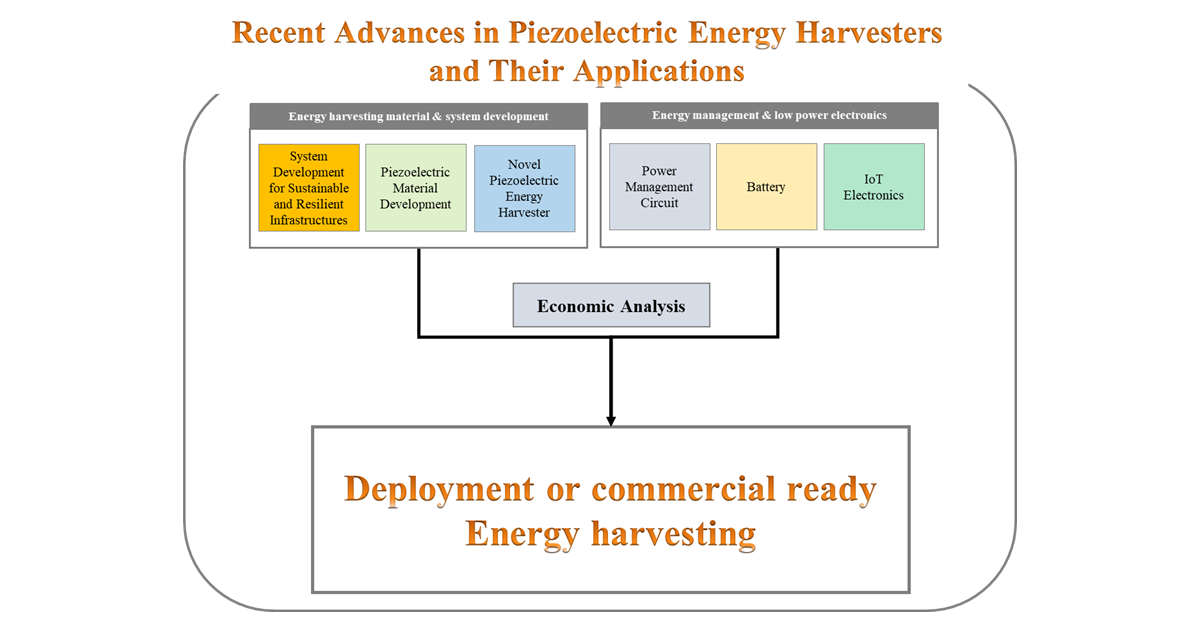- 3.2Impact Factor
- 7.3CiteScore
- 17 daysTime to First Decision
Recent Advances in Piezoelectric Energy Harvesters and Their Applications
This special issue belongs to the section “D1: Advanced Energy Materials“.
Special Issue Information
Dear Colleagues,
This Special Issue is proposed to encourage further research of piezoelectric energy harvesting and its applications. For two decades, piezoelectric energy harvesting, an interdisciplinary research topic, has been developed in research areas such as material sciences, mechanical engineering, civil engineering, and electrical engineering.
Demand for self-powered IoT systems in industry, military, and government has increased overtime and research for commercial- or deployment-ready energy harvesters is critically important. The scope of this Special Issue is the mechanical design of piezoelectric energy harvesting, considering real applications, economic analysis for commercial energy harvesting, low-power management circuits and systems, battery management circuits and systems, analysis and study of available energy for energy harvesting, emerging technology of piezoelectric material, and additive manufacturing for piezoelectric energy harvesting. Original contributions including the state of the art, benefits of emerging technologies, experimental studies, or which investigate novel schemes and applications are welcome.
Topics relevant to the Special Issue include but are not limited to:
- Novel piezoelectric energy harvesting systems;
- Low power management circuits and systems;
- Economic analysis for commercial energy harvesting;
- Additive manufacturing for piezoelectric energy harvesting;
- Energy management algorism for sustainable monitoring systems;
- Piezoelectric energy harvesting for sustainable and resilient infrastructures;
Dr. Yooseob Song
Dr. Hyunjun Jung
Guest Editors
Manuscript Submission Information
Manuscripts should be submitted online at www.mdpi.com by registering and logging in to this website. Once you are registered, click here to go to the submission form. Manuscripts can be submitted until the deadline. All submissions that pass pre-check are peer-reviewed. Accepted papers will be published continuously in the journal (as soon as accepted) and will be listed together on the special issue website. Research articles, review articles as well as short communications are invited. For planned papers, a title and short abstract (about 250 words) can be sent to the Editorial Office for assessment.
Submitted manuscripts should not have been published previously, nor be under consideration for publication elsewhere (except conference proceedings papers). All manuscripts are thoroughly refereed through a single-blind peer-review process. A guide for authors and other relevant information for submission of manuscripts is available on the Instructions for Authors page. Energies is an international peer-reviewed open access semimonthly journal published by MDPI.
Please visit the Instructions for Authors page before submitting a manuscript. The Article Processing Charge (APC) for publication in this open access journal is 2600 CHF (Swiss Francs). Submitted papers should be well formatted and use good English. Authors may use MDPI's English editing service prior to publication or during author revisions.
Keywords
- Piezoelectric energy harvesting
- Low power management circuit
- Deployment ready
- Commercialization
- Additive manufacturing
- Structural health monitoring
- Sustainable infrastructure

Benefits of Publishing in a Special Issue
- Ease of navigation: Grouping papers by topic helps scholars navigate broad scope journals more efficiently.
- Greater discoverability: Special Issues support the reach and impact of scientific research. Articles in Special Issues are more discoverable and cited more frequently.
- Expansion of research network: Special Issues facilitate connections among authors, fostering scientific collaborations.
- External promotion: Articles in Special Issues are often promoted through the journal's social media, increasing their visibility.
- e-Book format: Special Issues with more than 10 articles can be published as dedicated e-books, ensuring wide and rapid dissemination.

